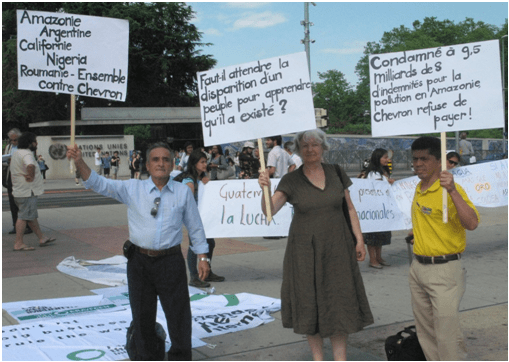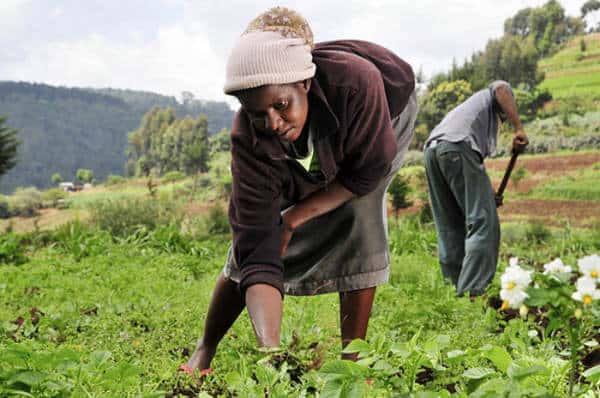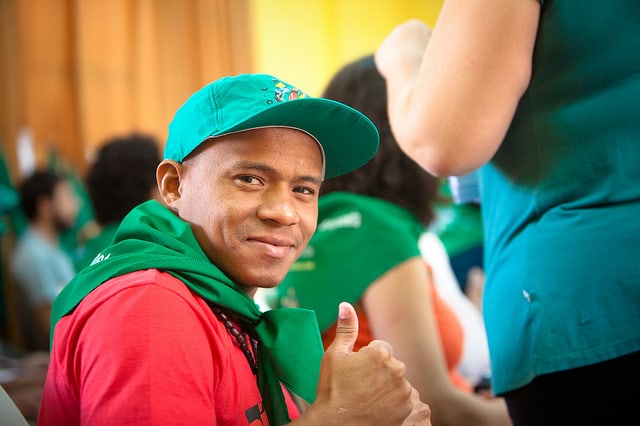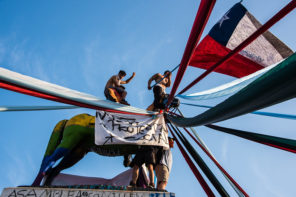The anthropology of human rights has devoted increasing attention to how diverse groups and societies interpret and implement (or not) international legal norms. The pioneering work of Sally Merry and her collaborators on how global women’s rights norms are enacted in local contexts saw this as a “vernacularization” process. [i] Numerous scholars have studied the ways civil society organizations build alliances across boundaries of language, nation, ethnicity, class, and religion; construct shared imaginaries; and take rights claims to international governance venues in hopes of legislating new global norms. Few, however, have explicitly analyzed this in terms of what we might term “vernacularization in reverse.” [ii] To be concrete, reverse vernacularization involves the development of shared understandings and demands between, say, residents of a community in the Philippines affected by the mining giant Glencore and their counterparts near Glencore mines in Colombia, Peru, Zambia, and the Democratic Republic of Congo. Or, to take another example, small farmers in Western Europe who seek to overturn prohibitions on saving and exchanging seeds and those in Brazil who face similar restrictions.
Two important rights-claiming efforts illustrative of reverse vernacularization were recently on display in Geneva during the second half of June 2014 as part of discussions in and around the twenty-sixth session of the United Nations Human Rights Council.
First, the Council passed a resolution to set up a UN Working Group to draft a binding treaty on the human rights obligations of transnational corporations (TNCs). Ecuador—whose Amazonian region was famously devastated by oil giant Texaco (later acquired by Chevron)—sponsored the resolution, along with South Africa. [iii] A Treaty Alliance, composed of more than 500 civil society organizations from across the globe, elaborated an International Peoples’ Treaty on the Control of Transnational Corporations and brought scores of activists from diverse movements to Geneva to lobby. A proposed UN Declaration on the Rights of Peasants was also on the Human Rights Council’s agenda. [iv] In this case, Bolivia introduced a resolution that sought authorization to continue work initiated in July 2013 in the first session of the Open-Ended Intergovernmental Working Group (OEIWG) on a UN Declaration on the Rights of Peasants and Other People Working in Rural Areas.
This proposal passed with near-unanimous backing from Council member states from the Global South and only five negative votes—USA, South Korea, the Czech Republic, Romania, and the United Kingdom (other European Union states on the Council abstained). The Bolivian ambassador, who chairs the OEIWG, will now prepare a new draft of the Declaration for the second session that should take place in November 2014. Small farmers from half a dozen European countries and a few from South Africa, Argentina, and elsewhere also converged on Geneva to support this initiative.
The international human rights regime is fundamentally a state-centered system. International treaties specify rights, and state parties to those agreements are obligated to respect, protect, and fulfill those rights. Declarations, as opposed to treaties or conventions, are nonbinding “soft law,” but they nonetheless establish ethical, moral frameworks and frequently serve as templates for national-level laws.
Social movements often intentionally act as if declarations are “hard law” in making claims on national governments. Of course, many states that sign conventions (or nonbinding declarations) systematically violate them, and, as a practical matter, the international system is limited in its monitoring and enforcement capacity. But in many respects the system has become increasingly robust, with the creation of the International Criminal Court, the International Criminal Tribunals for Rwanda and the former Yugoslavia, a growing number of universal jurisdiction laws (especially in western Europe), and increased attention to economic, social, and cultural rights.
States are not the only violators of human rights, however, and the international system has historically paid only sporadic attention to non-state actors, particularly TNCs. Do TNCs have human rights obligations?
Do countries where TNCs are domiciled have obligations to regulate corporations chartered there but with operations elsewhere? Do trade and investment agreements shield corporations from human rights–related scrutiny and responsibilities? Since the 1970s, various UN bodies and agencies have tried to monitor and regulate TNCs, but the frameworks that emerged have been insufficient to curb the worst abuses or expanding TNC influence within the UN itself. [v] The International Labor Organization’s 1977 Multinational Enterprises Declaration provided corporations “guidance,” particularly on labor standards. Kofi Annan’s 2003 Global Compact and the 2011 Guiding Principles on Business and Human Rights, developed by Harvard professor and Annan advisor John Ruggie, rely on voluntary corporate codes of conduct. (In what might be a little-remarked note of intra–Ivy League rivalry, Columbia economist and Nobel Laureate Joseph Stiglitz came out in support of a binding TNCs treaty at a December 2013 UN Forum on Business and Human Rights.) The limitations of voluntary guidelines reflect a broader sense of asymmetry. While communities impacted by business malfeasance often have little access to judicial or administrative remedies, TNCs can sue governments for vast sums in binding tribunals, such as the World Bank’s Center for the Settlement of International Disputes, and states can sue other states on behalf of “their” TNCs in the World Trade Organization’s Dispute Settlement Mechanism.
Both the proposed TNCs Treaty and the Peasants’ Rights Declaration raise thorny questions that proponents are only beginning to acknowledge. Given developed countries’ hostility toward a treaty on TNCs, one might ask whether it’s useful to have a convention that is not ratified, and therefore binding, on states where the most problematical TNCs are domiciled. Indeed, the June session of the Human Rights Council was marked by division between activists and member states pushing a binding treaty on TNCs and backers of an alternative (and also successful) resolution, sponsored by Norway, that sought to improve implementation of the existing Guiding Principles and to investigate the pros and cons of a binding TNCs instrument. Activists and diplomats who backed the treaty approach argue that the first step is to obtain a binding agreement so that broader ratification and better implementation can eventually be reached. The precedent of the UN Convention on Migrant Workers, however, which entered into force in 2003 and has been ratified by 47 “sending” states but not by a single major “receiving” one, suggests that trust in further ratifications at some unspecified point in the future may be a pipe dream. The proposed TNCs instrument, at least the “Peoples’ Treaty” version, has little to say about Non-transnational corporations that violate human rights except insofar as these are subsidiaries of, or suppliers or subcontractors for, TNCs (as was the case with the garment factories in the notorious Rana Plaza building in Bangladesh that collapsed in April 2013, killing more than a thousand workers).
Yet many domestic investors in extractive activities, plantations, and assembly and service industries are among the worst human rights violators.
Indeed, the transnational character of the better-known TNCs may be precisely what makes them “emblematic cases,” vulnerable to denunciations and pressure at the international level. Another question concerns how to penalize and remedy impacts that are not centered in any one place. A recent authoritative study of the 90 largest carbon emitters since the mid-nineteenth century —states and TNCs—placed Chevron, the same company that devastated eastern Ecuador, at the top of the list.[vi] Perhaps this primarily concerns climate change negotiations, but it remains true that environmental assaults on vulnerable communities are often of this non-place-based sort.
Some of these questions are relevant not only to the proposed TNCs treaty but to the Peasants’ Rights Declaration as well, although here additional tensions lurk beneath the surface. The draft Declaration text debated in 2013 had substantial input from peasant activists, especially those in the transnational Vía Campesina movement, which began pushing for a similar declaration as early as 2001. Other rural groups—transnational movements of pastoralists, fisher folk, and nomads—now want to be covered by the Declaration, but incorporating them and reconciling their demands with those of peasants may prove challenging, especially given ongoing conflicts, notably in Africa, between herders and agriculturalists. Many of the rights claimed in the 2013 Declaration draft, such as freedom of expression and assembly, are already amply protected by other international instruments.
Some claims, however, push far beyond existing norms, calling for the “right to reject” intellectual property rules and “outside” interventions in peasants’ “territories.” The latter demand raises the specter of collective, as opposed to individual, rights, which Western countries have consistently opposed. Even proponents of the Declaration recognize that the more contentious language will have to be toned down to build support for the new instrument. But how much? The Bolivian delegation now has to come up with a new “zero draft.” Will the “right to reject” turn into a more anodyne “right to choose” or—even worse—“free, prior and informed consent,” a principle already enshrined in the UN Declaration on the Rights of Indigenous Peoples (and to which TNCs, such as Coca-Cola, are not necessarily averse)? If the draft’s radical language is softened, will peasant activists from so many parts of the world who placed their hopes in the UN process continue to feel that they are “owners” of the Declaration?

Peasants have long been victims of discrimination, hunger, and extreme exploitation, but they too are intent on gaining visibility as rights holders. As a Spanish farmer exclaimed in a heated exchange with a European delegate at a UN side event, “It’s not just the substance of what’s in the Declaration; it’s about our dignity.” The hope, then, for movements that seek to rein in corporate malefactors and to guarantee the rights of peasants is that new international instruments will change the global commonsense, close legal gaps in protection, and provide practical tools for victims of human rights violations who seek redress, either at the international level or in the countries where they live.
Notes & References
[i] Merry, Sally Engle. 2006. Human rights and gender violence: Translating international law into local justice. Chicago: University of Chicago Press.
Support from the PSC-CUNY Grant Program and the National Science Foundation is gratefully acknowledged. Many thanks to Christophe Golay for commenting on an earlier draft.











